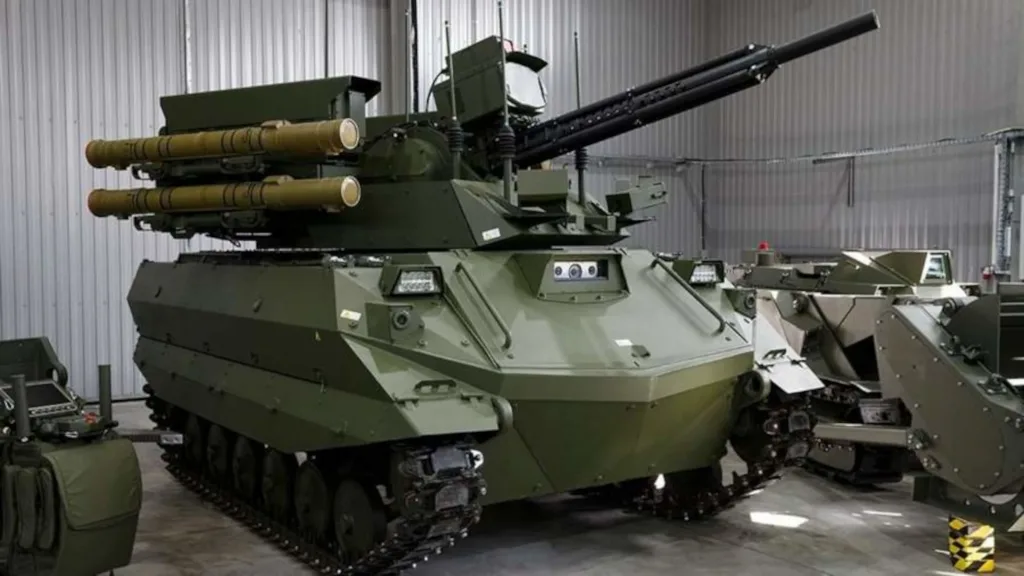The Indian Ministry of Defence recently unveiled an unmanned Ground Vehicle (UGV), which will undergo testing by the Indian Army, the Indian Navy, and the Indian Air Force as part of an upcoming military exercise. This innovative vehicle was conceived and given the moniker “Titan Autonomous Tank Killer” by Gridbots Technologies, an industrial technology firm. This astounding two-ton hardware was designed to independently locate and destroy enemy tanks, greatly enhancing New Delhi’s defensive capabilities.
The Titan’s armoury of weapons is notable. This UGV is equipped with a state-of-the-art Amogha III missile produced by another Indian industrial firm, Bharat Dynamics Limited. It’s a portable missile with a “fire and forget” capability, meaning that once it’s fired, the shooter doesn’t have to worry about guiding it in the appropriate direction. To top it all off, the Amogha-III has a tandem warhead with two explosive charges that detonate quickly. The first charge, called the precursor charge, penetrates the enemy’s armour and creates the opening. A second charge is set off inside this gap to maximise the damage to the tank.
Using a tandem warhead arrangement greatly improves the missile’s ability to kill heavily armoured targets. The missile’s flexibility comes from the fact that it can be fired either straight down or from above.
However, The Titan’s abilities are not limited to offensive firepower. Remarkably, the TITAN robot can reach up to 20 kilometres per hour for such a large vehicle despite its tracked chassis. And because its radio has a range of 20 kilometres, it can maintain regular contact with command centres and other forces spread out over a battlefield.

The versatility of the Titan is another feature that sets it distinct from other vehicles. It can be configured to carry out various tasks, from inspection to surveillance to reconnaissance, thanks to its substantial payload capacity of 1.5 tonnes. This device is outfitted with an automated target tracking system, guaranteeing accurate recognition and engagement of adversary targets when combined with a thermal sight.
Compared to the 3-ton Russian Marker anti-tank UGV currently in use in Ukraine, Titan is lacking in features. The Marker robot, developed by the Russian military industry, has a claimed maximum range of 1,000 kilometres and a maximum autonomy of sixty hours. The wheeled variant can reach up to 80 km/h, while the tracked variant has a top speed of 70 km/h. The Marker robotic platform can detect and map its surroundings to a distance of over 100 metres. This allows the operator to adjust its movement at the right time without physically intruding. The Marker anti-tank UGV has four RPG-26 anti-tank rocket launchers, all controlled from a remote weapon station. The vehicle’s right turret houses these launchers. The rocket possesses a high explosive anti-tank warhead that can penetrate 440 mm of armour, 1 m of reinforced concrete, or 1.5 m of brickwork thanks to its 72.5 mm diameter single-shaped charge. Theoretically, its maximum useful range is around 250 metres. In comparission, Titan can carry just one ATMG.

Larger UGVs are also in use. The Tracked Hybrid Modular Infantry Systems (THeMIS) is an unmanned ground vehicle (UGV) developed by the Estonian army company Milrem Robotics. The THeMIS from Estonia is larger and can carry more destructive ordnance than Russia’s Uran-9. The Uran-9 looks like a menacing and ruthless killer robot since it has a 30mm 2A72 automatic gun and four 9M120-1 Ataka anti-tank guided missiles. The Netherlands pioneered the use of the machine gun-equipped THeMIS UGV.
In 2019, Iran showcased its Heidair-1 on social media, demonstrating that it had been working on creating its UGVs. The tiny beetle-shaped Iranian drone is likely designed to roll under armoured vehicles like tanks and people carriers before detonating.
New Delhi has produced military drone technology before. India has developed various war and surveillance robots to bolster its military might. These robots were designed for combat and capable of various tasks, including surveillance, target acquisition, and fighting. They have advanced weaponry and can operate in hostile environments.
A 6X6 utility vehicle (UGV) with a top speed of 20 kilometres per hour and a payload of 300 kilogrammes has been developed through a joint effort between the Defence Research and Development Organisation and its production partner, Larsen and Toubro. It can stay in one place for four hours and weighs 800 kilograms.
The DRDO’s Centre for Artificial Intelligence and Robotics (CAIR) created a remote-controlled mini-UGV dubbed DAKSH to find and remove unexploded ordnance. In an urban setting, it can get around a few problems. It can also be utilised in surveying and monitoring radioactive and chemical contamination. Daksh can be managed via a wired connection to an MCS at a distance of up to 100 metres or via a wireless connection up to 500 metres away. Reports indicate that 90% of its components are made in the country.
Numerous companies and educational institutions are investing time and money towards UGV growth. This group contains businesses such as Bharat Forge, Torus Robotics Private Limited, ECA Group, etc. Bharat Forge presented an unmanned ground vehicle (UGV) at the 2018 Army Technology (ARTECH) Seminar. To detect, identify, and dispose of Improvised Explosive Devices (IEDs) from a remote distance of one km, Torus Robotics has developed a Mobile Autonomous Robotic System (MARS) UGV for the DRDO in collaboration with the Army Design Bureau (ADB). The UGV also has the potential for intelligence and surveillance missions.
